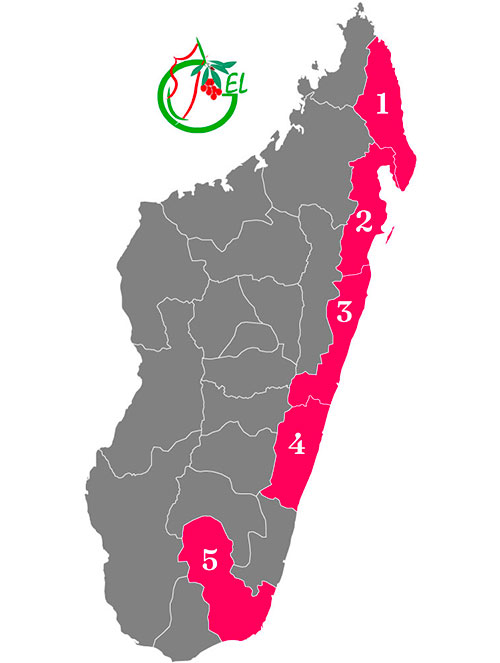Strategic sector
The madagascan lychee
The madagascan lychee
An export product
The lychee industry represents a major socio-economic challenge for Madagascar, and is one of the country’s leading export products. Each year, with around 20,000 tonnes of fresh fruit exported, it generates nearly €30 million in foreign currency. It directly or indirectly involves more than 100,000 people: growers and harvesters, transporters, packing station agents, etc. It makes a considerable contribution to employment and provides a livelihood for entire communities.
World's 5th largest producer
Madagascar is the 5th largest producer of lychees in the world and the 3rd largest exporter.
No. 1 producer in the southern hemisphere
Madagascar is the leading producer of lychees in the southern hemisphere (around 100,000 tonnes a year).
No. 1 exporter to Europe
20,000 T per year of sulphur-containing lychees
8 days of campaigning
To set the scene for the festive season
30 million
Annual foreign exchange receipts
+ More than 20,000 jobs
Direct to packaging stations
+ More than 100,000 families
Directly or indirectly affected
The madagascan lychee
The red island's lychee export regions
Generally speaking, the lychee is grown on the east coast of Madagascar, but it can also be found in the highlands. Historically, production zones have developed steadily and areas of concentration have gradually been defined according to the following factors:
▪ Humid tropical climate with a marked austral winter,
▪ Proximity to ports for export,
▪ Port infrastructure suitable for reefer vessels,
▪ Network of motorable roads for the rapid evacuation of highly perishable products from production points to the city.
At present, several major production areas have been identified (see map), but with a high concentration in the Atsinanana and Analanjirofo regions, as these have access to the town of Tamatave where the boat loading port is located, as well as the infrastructure for processing and packaging fresh produce.
On the other hand, the landlocked nature of other regions, particularly in the south-east and north-east of Madagascar, and the absence or inadequacy of the infrastructure needed for processing, packaging and transport, make it difficult to export the lychees that grow there. As a result, these products are destined for the local market.

The madagascan lychee
Farming and collection
The lychee is mainly farm-based, with over 60,000 small-scale producers and owners of lychee seedlings.
It is estimated that 80% of Madagascar’s total fruit production comes from trees that grow extensively and without any specific maintenance. These plants are grown around homes and villages. Ministry of Agriculture technicians call this type of plantation ‘extensive village-style cultivation’.
Professional growers, whose main activity is planting and maintaining fruit trees, account for 5% of production. Most lychee plantations are therefore extensive, of the ‘tree park’ or ‘extensive village plantation’ type. In addition to fruit production, the tree has a social and territorial function.
Production is based exclusively on collection.
The madagascan lychee
Organising a campaign
1. Maintenance and phenological monitoring
Between two campaigns, activities revolve around the upkeep and monitoring of the lychee vines.
The growers carry out the usual maintenance work: pruning the trees after the season, mulching and regular cleaning of the plantations, etc.
The CTHT is responsible for annual phenological monitoring to observe general production conditions and the development of the plantations from flowering to the optimum development stage for harvesting.
2. Harvesting and collection
When the start of the season is officially announced – usually in November – the production regions are abuzz with activity. Everyone involved – growers, collectors, transporters, exporters, logistics providers and others – has to harvest, transport and load the entire crop in just a few days.
There are more than 65,000 producers and over 45,000 workers involved in the lychee harvest.
4. Logistics and transport
Given their highly perishable nature, lychees are loaded at the port according to a predefined schedule and at a particularly fast pace: around 15,000 tonnes in 8 days.
A team of professionals specially dedicated to this task has been supporting the local port teams in carrying out these operations for almost 20 years.